HDMI fiber optic cables
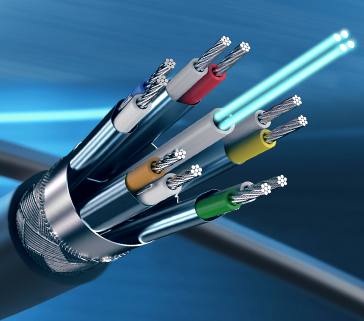
Conventional HDMI cables use all copper wires. The copper wires are good for a connection up to 30 ft. After that the signals can degrade.
Also the copper wire transmissions are subject to electromagnetic interference. Electric signals transmitted through conventional copper
HDMI cables are more inclined to suffer from electromagnetic and radiofrequency interference (EMI/RFI).
A powerful radio transmitter or large electrical machine can be a source of interference to electric signals.
In comparison, the light pulses which travel through optic fiber HDMI cables cannot be affected by EMI/RFI. It ensures a much better quality of the audio and video signals delivered through fiber optic HDMI cables.
Future proof your setup with fiber HDMI. As technology advances, the all copper cables simply will not be able to keep up. 8K is here and after that
you will almost certainly need fiber HDMI cables for video transmissions.
ADVANTAGES: Less Signal Interference and Longer signal distances than traditional HDMI copper cables
DISADVANTAGES: Cost for longer distances
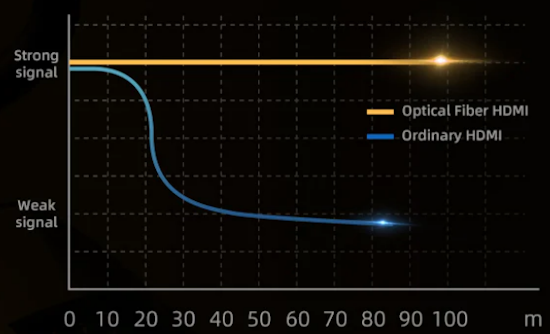
Gold: Longer distances using fiber optic HDMI cables.
Blue: Signal loss for traditional HDMI copper cables after 10m.
Fiber optic HDMI cables are made with optical fiber inside the cable.
The Optical fiber has certain advantages over copper wires.
What Is a Fiber Optic HDMI Cable?
A standard HDMI cable is made up of several twisted pairs of copper wiring, insulated and protected with shielding and silicon wraps.
A fiber optic HDMI cable, on the other hand, does away with the central twisted copper pair, but still retains seven to nine other copper wires.
At its core are four glass filaments which are encased in a protective coating.
Those glass strands transmit the data as pulses of light, instead of electricity.
All fiber optic HDMI cables are active, meaning they only operate in one direction and aren’t reversible. For example from a Blu-ray player
to a TV.
How Does a Fiber Optic HDMI Cable Work?
The fiber optic HDMI cables convey data using light or lasers. Light pulses through tiny glass filaments, transmitting the data. These thin strands are capable of sending a lot of impulses because of their thinness. To change the light into electrical signals and vice versa, converters are employed at both ends.
The optical fiber HDMI cable has the photoelectric conversion chip engine, which requires two photoelectric conversions
to realize the signal transmission. The electrical signal is converted into an optical signal, then the optical signal is transmitted in the optical fiber line, and then the optical signal is converted into an electrical signal. The signal is effectively transmitted from the SOURCE terminal to the DISPLAY terminal. The conventional HDMI cable uses electrical signal transmission and does not require two photoelectric conversions.
All fiber optic HDMI cables are active. The signal is converted from electrical to light and then back to electrical at the destination.
HDMI fiber optic cables that don't require USB power are just making use of the 5V power from the HDMI port meaning they are
efficient enough to carry the signal at that power level.
Fiber optic HDMI 2.0 cables can support 18 Gb/s speeds without signal loss and are meant for
distances up to 164 ft (50 m) for 4K resolution @ 60 Hz.

Specifications:
HDMI Version: 2.0
HDCP Version: 2.2
Supported Resolutions: 4K@60Hz, 4K@30Hz, 1080p/1080i, 720p/720i, 576p/576i, 480p/480i
Chroma Subsampling: 4:4:4, 4:2:2, 4:2:0
HDMI 2.0 Supported Features: HDR, ARC, CEC, EDID, 3D
Fiber optic HDMI 2.1 cables can support 48 Gb/s speeds without signal loss and are meant for
distances up to 328 ft (100 m) for 8K resolution @ 60 Hz or 4K resolution @ 120 Hz. Customized lengths up to 1000 ft. are possible.
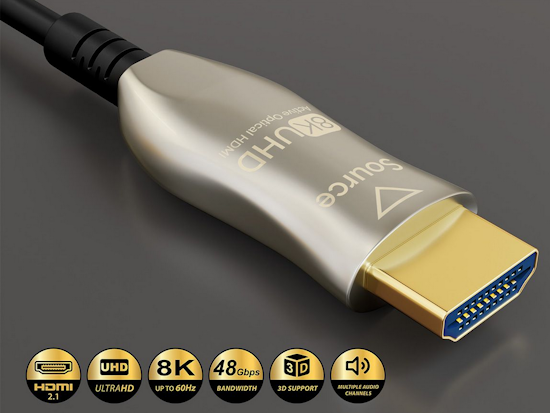
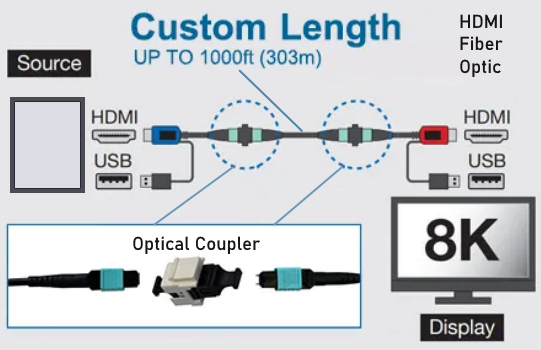
Fiber optic HDMI cables can send video and audio to a display like most standard copper HDMI cables.
These optical HDMI cables can support up to 32 uncompressed audio channels.
Most fiber optic HDMI cables also support an Audio Return Channel (ARC), allowing TVs with a built-in tuner to
send audio upstream to a surround sound audio receiver.
Fiber optic HDMI cables provide extended range to connect a device to a display.
Optical HDMI cables are also suitable for higher resolution displays since standard copper HDMI
cables are limited to around 10 feet (3 m) optimum distance.
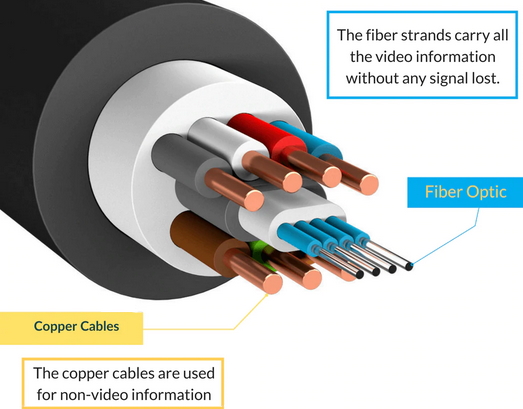
Fiber optic HDMI cables are mostly made up of 4 fiber cores plus 7 copper wires.
The former is used for data transmission; among the 7 copper wires, one is for power supply, one for CEC, two for sound return (ARC), and one set of DDC signal (two core wires are foamed and one ground wire is shielded by aluminum foil) for communication protocol.
HDMI AOC (Active Optical Cable) cables is a high-speed signal transmission solution consisting of two transceivers
and one optical jumper with 2 HDMI converters on both ends.
One end has the transmitter and the other end has the receiver so it is a one-way fiber optic communication.
The cables work like a regular copper HDMI cable, only they allow
for much longer distances.
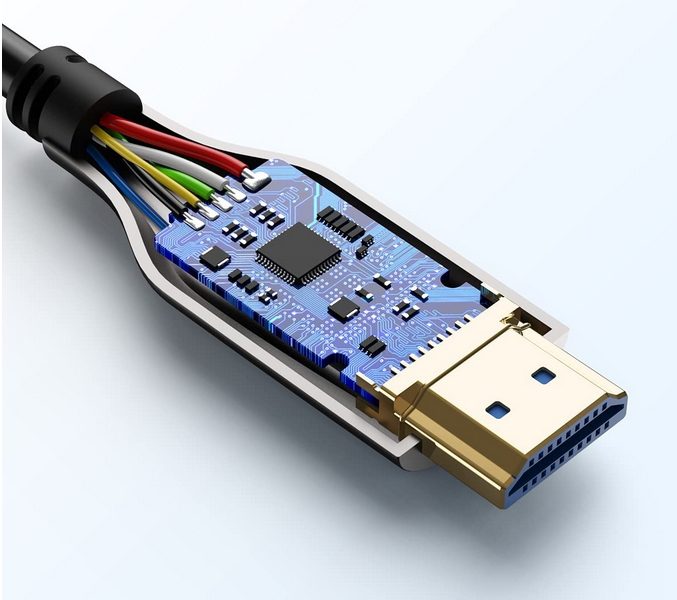
Less Signal attenuation
The long-distance signal transmission attenuation(signal loss) over optical fiber HDMI AOC cable is almost zero due to the photoelectric conversion technology, and the long-distance transmission can reach 500 meters.
The CP−AOCH/60 is an innovative active optical HDMI cable for 4K@60Hz (4:4:4) signal resolution up to 100 meters (328 ft). This hybrid−fiber cable features micro−HDMI ends with detachable HDMI connectors, making it easy to run through a conduit or other tight spaces.
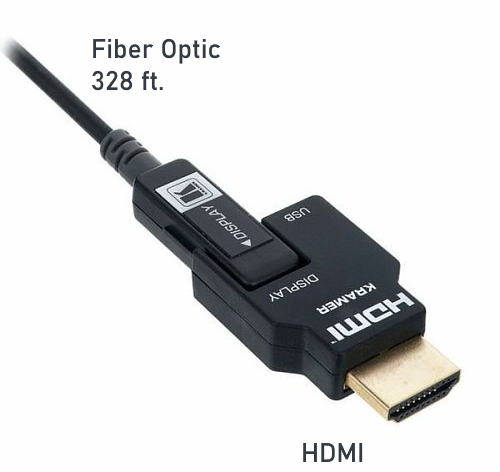
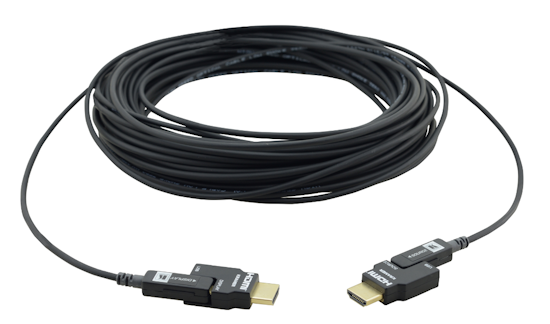
Cost:
3 ft. to 33 ft. cables are very affordable but the cost goes way up as the cable length increases.
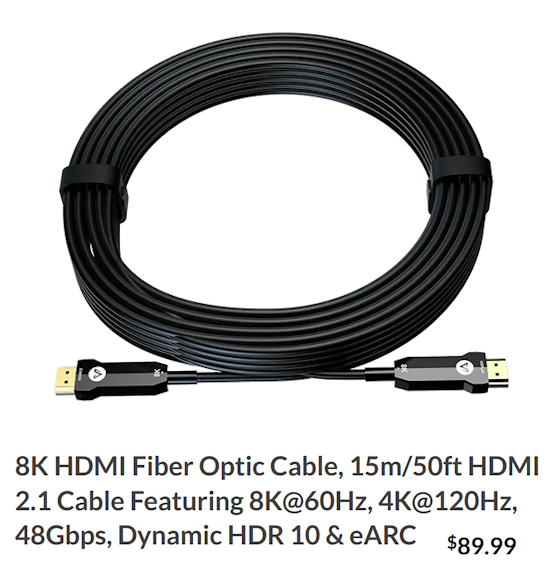
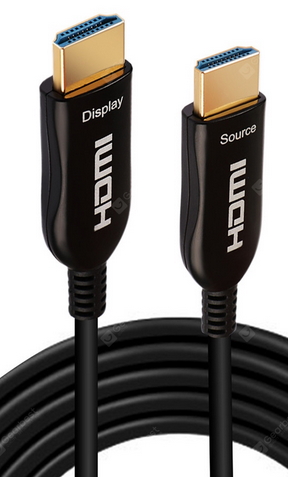
The HDMI AOC cables have to be installed in the proper configuration. The source end to the source device and the display end at the destination.
4K Fiber Optic HDMI Cable 75FT Long
• Monoprice.com HDMI cables
• Video distribution solutions over fiber
• Turntable
to PC hookup / record vinyl LPs to computer
• PC
to Stereo hookup - how to play computer thru sound system
• Audio
cassette to computer hookup - how to record audio cassettes to PC
• PC
stereo hookup
|

